Ameliorative Efficacy of Egyptian Pyramid Model Housing on Unilateral Nephrectomized Rats
Introduction
Nephrectomy (Nx) is a novel intervention having first been introduced for the treatment of renal cell carcinoma in 1969 [1]. Although surgical resection remains the standard of care in the treatment of renal carcinoma, Nx is also a recognized risk factor for developing Chronic Kidney Disease (CKD) [2,3]. Indeed, nephrectomy is a widely used model to study the mechanisms leading to renal damage in CKD [4]. The intra-renal vasculature is the most affected structure, preventing an appropriate blood flow, fаvoring the glomerular sclerosis [5]. CKD will certainly lead to the progression of Chronic Renal Failure (CRF) due to gradual sclerosis of renal tissue. In addition, nephrons are gradually lost in renal failure. Remaining nephrons are hypertrophied to compensate for the loss of renal function, and hyperfiltration in these remaining nephrons leads to further nephron loss [6].
Nephrectomy (Nx) is a novel intervention having first been introduced for the treatment of renal cell carcinoma in 1969 [1]. Although surgical resection remains the standard of care in the treatment of renal carcinoma, Nx is also a recognized risk factor for developing Chronic Kidney Disease (CKD) [2,3]. Indeed, nephrectomy is a widely used model to study the mechanisms leading to renal damage in CKD [4]. The intra-renal vasculature is the most affected structure, preventing an appropriate blood flow, fаvoring the glomerular sclerosis [5]. CKD will certainly lead to the progression of Chronic Renal Failure (CRF) due to gradual sclerosis of renal tissue. In addition, nephrons are gradually lost in renal failure. Remaining nephrons are hypertrophied to compensate for the loss of renal function, and hyperfiltration in these remaining nephrons leads to further nephron loss [6].
Experimental Animals
Healthy male Wistar albino rats (Rattus norvegicus), weighing 180-200g, were used. The animals were obtained from the National Research Center (NRC), Egypt. The rats were kept for one week before the commencement of the experiment for acclimatization. Animals were grouped and housed in polypropylene cages (five animals per cage) in air conditioned room at temperature of 25 ± 1 oC and under natural day and night cycle. Animals were feed standard chow pellets and drinking water.
The experimental protocol was approved by the Institutional Animal Care and Use Committee (IACUC) (CUFS/S/PHY/15/14) of Faculty of Science, Cairo University, Egypt.
A wooden pyramid model (Figure 1) of 30 in. height, 45 in. base and 41.5 sides was fabricated locally and used during the present [12].
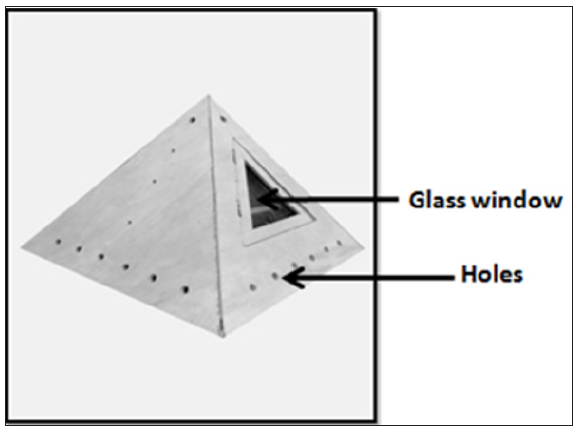 Unilateral Nepherectomy
Unilateral NepherectomyUnilateral nepherectomy was performed according to Fahmy et al. [12]. Briefly, laparatomy was performed under antiseptic conditions after anesthetization of rats with sodium pentobarbital (50mg/kg body weight; ip). The left kidney was removed following small longitudinal abdominal incision which then closed using a 4-0 silk thread (UNx group). In sham-operated animals, the left kidney was exposed and gently manipulated but left intact (sham group). All animals received normal saline of equal volume at corresponding time points. All the rats received 50μl of 0.2% ropivacaine subcutaneously for the post-operative analgesia.
Fourty two male Wistar rats were assigned equally into three main groups (14 rats for each).The sham-operated control (sham group) and unilateral nephrectomized rats (UNx group). Both groups maintained in their home cages for 24h and 48h. The third group (Pyramid housed group) in which UNx rats housed within the wooden pyramid (6hr/day) for 24h and 48h [13].
At the end of each experimental period, the rats were transferred to individual metabolic cages for 24h and urine was collected. During this time, the rats had free access to water. The collected urine samples were freed from fecal contamination and the urine volume was measured by using the measuring cylinder. The urine samples were centrifuged for 10 minutes and the urine supernatant was then stored at −70 °C until analysis.
Animals were euthanized under deep anaesthesia with sodium pentobarbital. Blood was collected in centrifuge tubes then centrifuged at 3000rpm for 20 minutes. Serum stored at -20 oC until used for biochemical and hormonal assays. Right kidney was removed and immediately blotted using filter paper to remove traces of blood and weighted then suspended in 10% formal saline for fixation preparatory to histological processing.
The appropriate kits (Bio-Diagnostic, Dokki, Giza, Egypt) were used for the determination of sodium, potassium and calcium ions by colorimetric method according to the method described by Trinder [14]; Sunderman and Sunderman [15] and Gindelar and king [16] respectively
Urea was determined by urease-berthelot method using Biodiagnostic kits, according to the method described by Fawcett and Soctt [17]. Total protein was determined by colorimetric method using Biodiagnostic kits, according to the method described by Gornal et al. [18]. Uric acid was determined by enzymatic colorimetric method using Biodiagnostic kits, according to the method described by Barham and Trinder [19]. Creatinine was determined by colorimetric method (End Point) using Biodiagnostic kits, according to the method described by Schirmeister et al. [20]. Creatinine Clearance was determined according to the following equation:

Hormonal Analyses
Plasma levels of renin, angiotensin and aldosterone were determined using mouse/rat ELISA kits (Cat# SL0617Ra, SL0061Ra and SL0040Ra, respectively, Sunlong Biotech Co. LTD).
Statistically, the data of the present study were analysed according to Shapiro-Wilk and Kolmogorov analysis. All the statistical analyses done on the bases of the parametric analysis as the raw data were normally distributed. Values were expressed as mean ± SEM. To evaluate differences between the groups studied, one way Analysis of Variance (ANOVA) with the simple t-test was used to compare the group means and P < 0.05 was considered statistically significant. SPSS for Windows (version 15.0) was used for the statistical analysis.
Effect of Egyptian Pyramid Housing on Right Kidney Weight in Unilateral Nephrectomized Rats (UNx)
Housing UNx rats either inside their home cages or inside the Egyptian pyramid model induced significant increase (P< 0.05) in the weight of the right kidney as compared to sham group following 24 and 48 h of nephrectomy, respectively (Table 1).
 Note: Values are means ± SEM (n=7 per group) a: Significant at (P< 0.05) as compared to the corresponding sham group. b: Significant at (P< 0.05 ) as compared to the corresponding home cage group.
Note: Values are means ± SEM (n=7 per group) a: Significant at (P< 0.05) as compared to the corresponding sham group. b: Significant at (P< 0.05 ) as compared to the corresponding home cage group.Data recorded in Table 2 showed that unilateral nephrectomy induced significant (P< 0.05) increase in the urine sodium and calcium levels concomitant with marked decrease of their serum levels as compared to the corresponding sham group. However, housing of UNx rats inside the Egyptian pyramid for 24 and 48 h induced significant (P< 0.05) decrease in the urine sodium and calcium levels with increase in their serum level as compared to UNx rats that housed in their home cage. Levels of urine potassium ions decreased significantly (P< 0.05) following nephrectomy for 24 and 48 h as compared to the corresponding sham groups (Table 2). Housing of nephrectomized rats inside the Egyptian pyramid for 24 and 48 h significantly (P< 0.05) increased potassium ions excretion in urine.
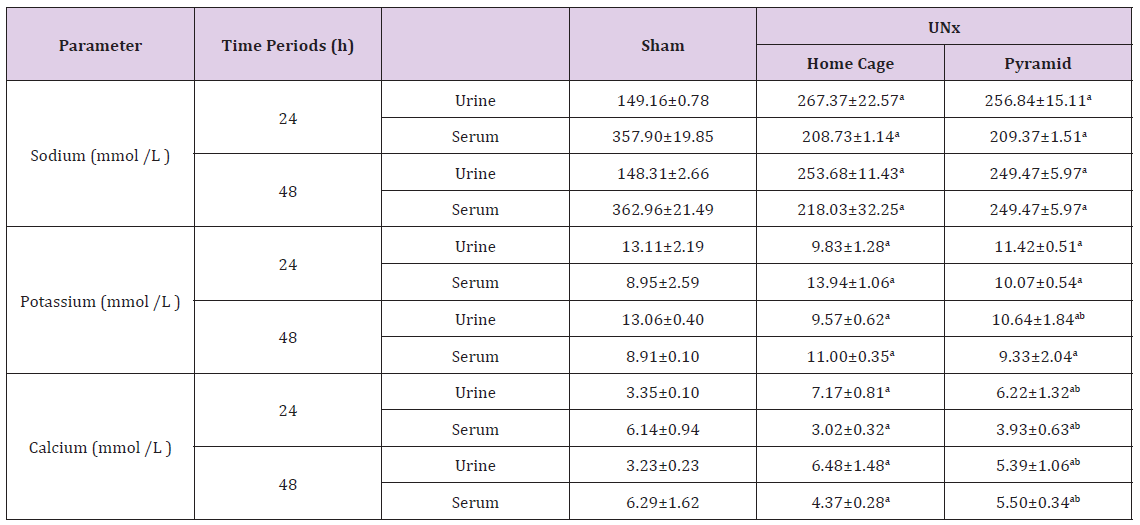 Note: Values are means ± SEM (n=7 per group). a: Significant at (P< 0.05 ) as compared to the corresponding sham group. b: Significant at (P< 0.05 ) as compared to the corresponding home cage group.
Note: Values are means ± SEM (n=7 per group). a: Significant at (P< 0.05 ) as compared to the corresponding sham group. b: Significant at (P< 0.05 ) as compared to the corresponding home cage group.Data illustrated in Table 3 recorded significant reduction (P< 0.05) in the creatinine level of UNx rats either housed inside their home cages or inside the Egyptian pyramid model for 24 and 48 h as compared to the corresponding sham groups. However, serum creatinine level significantly increased (P< 0.05) in UNx rats either housed inside their home cages or inside the Egyptian pyramid model for 24 and 48 h as compared to the corresponding sham groups (Table 3). The creatinine clearance significantly decreased (P< 0.05) in UNx rats housed in their home cages and inside the Egyptian pyramid model following 24 h of nephrectomy. On the other hand, creatinine clearance increased significantly (P< 0.05) only after housing UNx rats inside the Egyptian pyramid model following 48 h (Table 3).
 Note: Values are means ± SEM (n=7 per group). a: Significant at (P< 0.05 ) as compared to the corresponding sham group. b: Significant at (P< 0.05 ) as compared to the corresponding home cage group.
Note: Values are means ± SEM (n=7 per group). a: Significant at (P< 0.05 ) as compared to the corresponding sham group. b: Significant at (P< 0.05 ) as compared to the corresponding home cage group.Figures 2 & 3 demonstrated significant increase (P< 0.05) in proteinuria with concomitant significant decrease (P< 0.05) in total serum protein level in home cage UNx group as compared to sham group after 24 and 48 h following nephrectomy. The obtained data also showed significant decrease (P< 0.05) in the levels of urine urea and uric acid in home cage UNx rats as compared to sham group (Figures 4-7). On the other hand, their levels increased significantly in the serum (P< 0.05) of home cage UNx rats after 24 and 48 h following nephrectomy. However, housing of rats inside the Egyptian pyramids for 24 and 48 h significantly (P< 0.05) ameliorate these effects and restore their levels towards the control values (Figures 4-7).
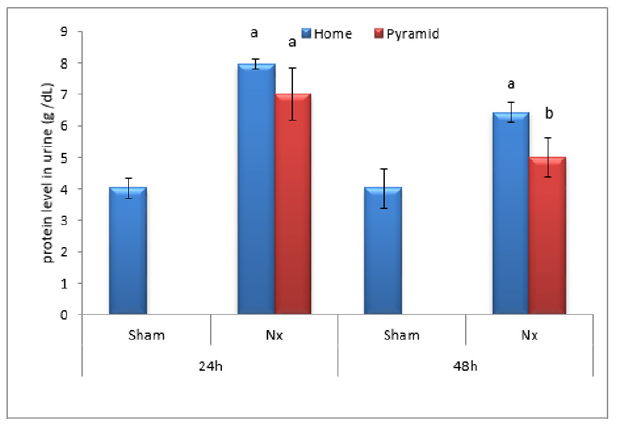 Figure 3:Effect of Egyptian pyramid housing on serum protein level (g/dl) and in Unilateral Nephrectomized Rats (UNx). Values are means ± SEM (n=7 per group). a: Significant at (P< 0.05 ) as compared to the corresponding sham group. b: Significant at (P< 0.05 ) as compared to the corresponding home cage group.
Figure 3:Effect of Egyptian pyramid housing on serum protein level (g/dl) and in Unilateral Nephrectomized Rats (UNx). Values are means ± SEM (n=7 per group). a: Significant at (P< 0.05 ) as compared to the corresponding sham group. b: Significant at (P< 0.05 ) as compared to the corresponding home cage group.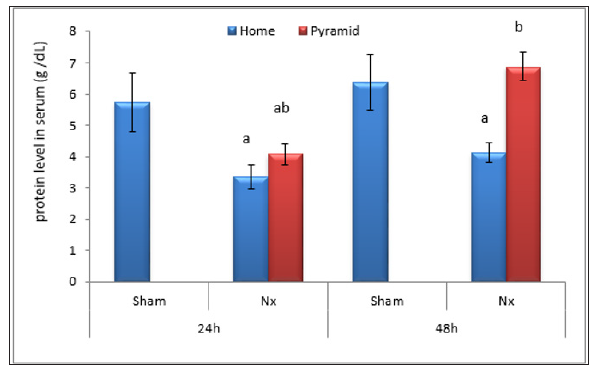 Figure 4: Effect of Egyptian pyramid housing on urea level in urine (g/dl) and in Unilateral Nephrectomized Rats (UNx). Values are means ± SEM (n=7 per group). a: Significant at (P< 0.05 ) as compared to the corresponding sham group. b: Significant at (P< 0.05 ) as compared to the corresponding home cage group.
Figure 4: Effect of Egyptian pyramid housing on urea level in urine (g/dl) and in Unilateral Nephrectomized Rats (UNx). Values are means ± SEM (n=7 per group). a: Significant at (P< 0.05 ) as compared to the corresponding sham group. b: Significant at (P< 0.05 ) as compared to the corresponding home cage group.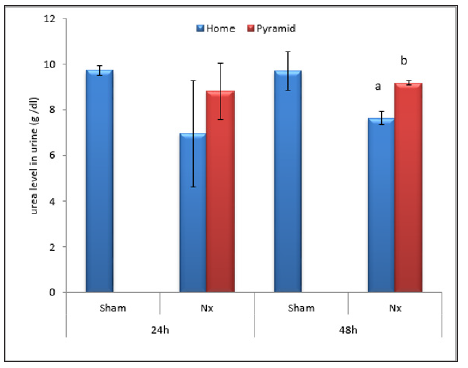 Figure 5: Effect of Egyptian pyramid housing on serum urea level (g/dl) and in Unilateral Nephrectomized Rats (UNx). Values are means ± SEM (n=7 per group). a: Significant at (P< 0.05 ) as compared to the corresponding sham group. b: Significant at (P< 0.05 ) as compared to the corresponding home cage group.
Figure 5: Effect of Egyptian pyramid housing on serum urea level (g/dl) and in Unilateral Nephrectomized Rats (UNx). Values are means ± SEM (n=7 per group). a: Significant at (P< 0.05 ) as compared to the corresponding sham group. b: Significant at (P< 0.05 ) as compared to the corresponding home cage group. Figure 6: Effect of Egyptian pyramid housing on urine uric acid level (mg/dl) in Unilateral Nephrectomized Rats (UNx). Values are means ± SEM (n=7 per group). a: Significant at (P< 0.05 ) as compared to the corresponding sham group. b: Significant at (P< 0.05 ) as compared to the corresponding home cage group.
Figure 6: Effect of Egyptian pyramid housing on urine uric acid level (mg/dl) in Unilateral Nephrectomized Rats (UNx). Values are means ± SEM (n=7 per group). a: Significant at (P< 0.05 ) as compared to the corresponding sham group. b: Significant at (P< 0.05 ) as compared to the corresponding home cage group.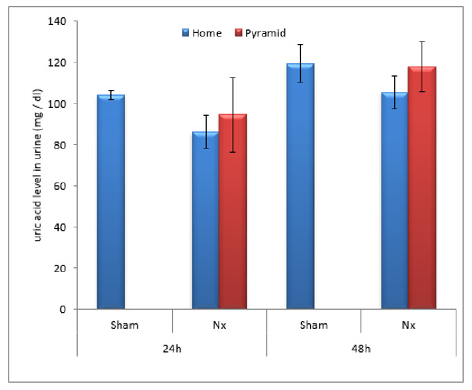 Figure 7: Effect of Egyptian pyramid housing on serum uric acid level (mg/dl) and in Unilateral Nephrectomized Rats (UNx). Values are means ± SEM (n=7 per group). a: Significant at (P< 0.05 ) as compared to the corresponding sham group. b: Significant at (P< 0.05 ) as compared to the corresponding home cage group.
Figure 7: Effect of Egyptian pyramid housing on serum uric acid level (mg/dl) and in Unilateral Nephrectomized Rats (UNx). Values are means ± SEM (n=7 per group). a: Significant at (P< 0.05 ) as compared to the corresponding sham group. b: Significant at (P< 0.05 ) as compared to the corresponding home cage group.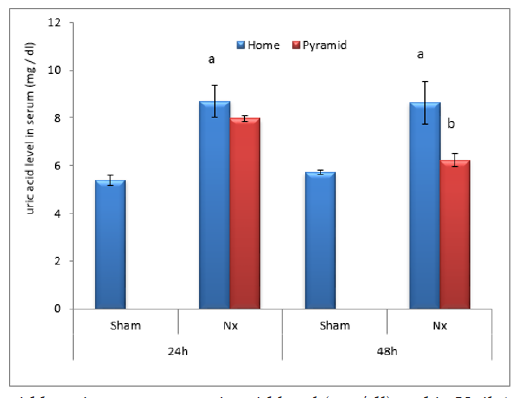 Effect of Egyptian Pyramid Housing on Reinin, Angiotensin and Aldosterone in Unilateral Nephrectomized Rats (UNx)
Effect of Egyptian Pyramid Housing on Reinin, Angiotensin and Aldosterone in Unilateral Nephrectomized Rats (UNx)Figure 8: Effect of Egyptian pyramid housing on renin level (mmol/l) and in Unilateral Nephrectomized Rats (UNx). Values are means ± SEM (n=7 per group). a: Significant at (P< 0.05 ) as compared to the corresponding sham group. b: Significant at (P< 0.05 ) as compared to the corresponding home cage group.
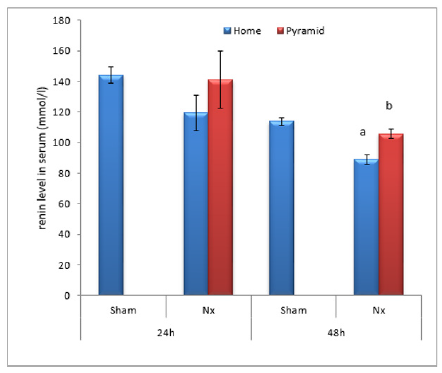 Data illustrated in Figures 8-10 showed significant decrease (P< 0.05) in the levels of serum reinin, angiotensin and aldosterone following unilateral nephrectomy in rats as compared to sham group. Levels of the studied hormones significantly increased after housing UNx rats inside the Egyptian pyramid for 24 and 48 h.
Data illustrated in Figures 8-10 showed significant decrease (P< 0.05) in the levels of serum reinin, angiotensin and aldosterone following unilateral nephrectomy in rats as compared to sham group. Levels of the studied hormones significantly increased after housing UNx rats inside the Egyptian pyramid for 24 and 48 h.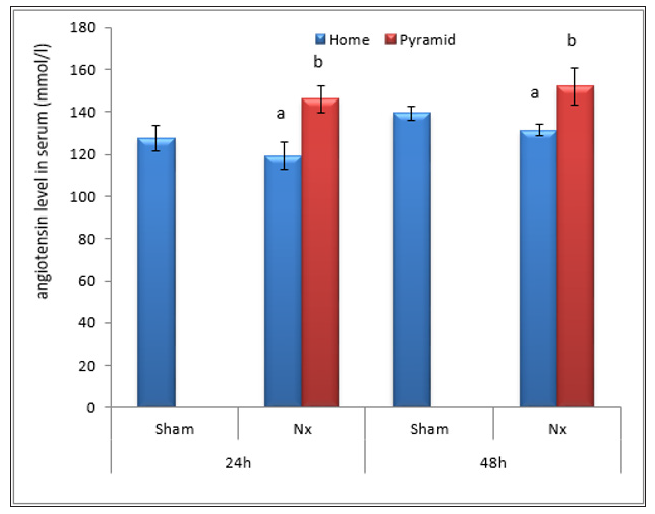 Figure 10: Effect of Egyptian pyramid housing on aldosterone level (mmol/l) and in Unilateral Nephrectomized Rats (UNx). Values are means ± SEM (n=7 per group). a: Significant at (P< 0.05 ) as compared to the corresponding sham group. b: Significant at (P< 0.05 ) as compared to the corresponding home cage group.
Figure 10: Effect of Egyptian pyramid housing on aldosterone level (mmol/l) and in Unilateral Nephrectomized Rats (UNx). Values are means ± SEM (n=7 per group). a: Significant at (P< 0.05 ) as compared to the corresponding sham group. b: Significant at (P< 0.05 ) as compared to the corresponding home cage group.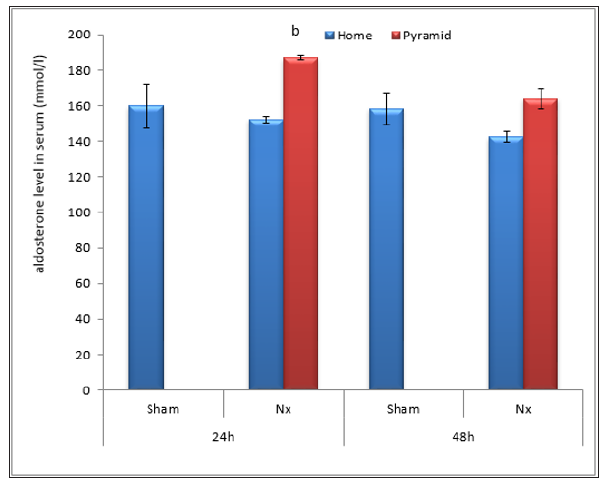 Histological Findings
Histological FindingsFigure 11 illustrate the histological alterations in kidney of UNx rats following housing inside the Egyptian pyramid model. Figure 11A & 11B represent microscopic examination of kidney in sham groups showing normal renal tubules and renal glomeruli. Dilated glomeruli with focal area of vacuolated renal tubules (arrows) were observed in UNx rats housed inside their cages for 24 and 48 h (Figure 11C & 11D). Housing UNx rats for 24 and 48 h inside the pyramid model demonstrated healthy renal tissue (Figure 11E & 11F).
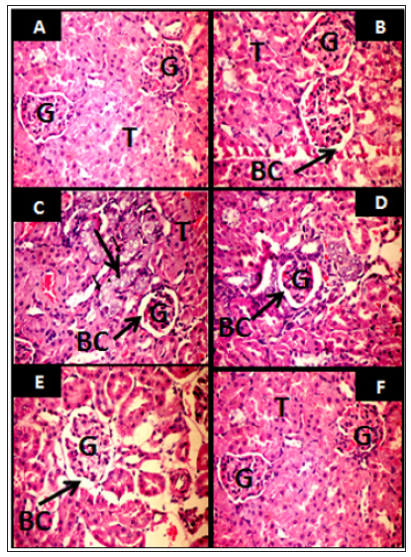 Discussion
DiscussionThe pyramid shape is being seen as a supernatural source of energy of the universe. The energy power inside the pyramids is a way to recover the Electro-Magnetic Fields (EMF) that have been essential for the communication of living cells [21]. Now the pyramids are being used very efficiently for balancing the centres of energy in human body, medical healing and anti-stress effects [22,23]. To our knowledge the effectiveness of the Egyptian pyramid model housing in preventing the renal failure following surgical resection of renal carcinoma not studied till now. Thereby, the present study postulated that housing of nephrectomized rats in the early stages (24 and 48h) inside a model of the Egyptian pyramid may be preventing renal failure that concomitant with the Unilateral Nephrectomy (UNx).
One of the best recognized mechanisms of renal failure following nephrectomy is hyperfiltration in the remaining nephrons, which is then thought to induce focal and segmental glomerulosclerosis, further damaging the remaining nephrons [24,25]. Thereby, the remaining kidney increases in size in response to hyperfiltration and begins to compensate for its missing partner [26,27]. The loss of renal mass or UNx is associated with functional and morphological adaptations in the remaining tissue. The most prominent response after UNx is an increase in size and weight of the remaining kidney. In consonance with the previous suggestion, the present study confirmed the finding of Gava et al. [28] and Mjøen et al. [29], who recorded significant increase in the weight of right kidney following UNx in rats. Moreover, Abdellatif et al. [30] reported that UNx may be associated with enlargement and hypertrophy of the remaining kidney.
The present study showed that housing nephrectomized rats inside model of the Egyptian pyramid may be a potential new strategy prevents CKD following renal tumor resection. Also, the current study suggested that pyramid environment plays an important role in ameliorating the serious effects of nephrectomy by enhancing kidney function. However, further studies are necessary to elucidate the mechanism by which pyramid environment reversed the actions of nephrectomy in rats.
Breast Cancer: The Accuracy of The Paus in Detecting pN2 and Factors that Lead to the True- and False-Negative Results-https://biomedres01.blogspot.com/2020/11/breast-cancer-accuracy-of-paus-in.html
More BJSTR Articles : https://biomedres01.blogspot.com


No comments:
Post a Comment
Note: Only a member of this blog may post a comment.